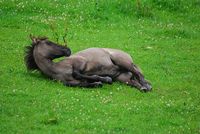Difference between revisions of "Category:Colic in Horses"
| Line 24: | Line 24: | ||
[[Epidemiology of Colic in Horses|Epidemiology]] | [[Epidemiology of Colic in Horses|Epidemiology]] | ||
| − | |||
| − | |||
| − | |||
| − | |||
| − | |||
| − | |||
| − | |||
| − | |||
| − | |||
| − | |||
| − | |||
| − | |||
| − | |||
| − | |||
| − | |||
| − | |||
| − | |||
| − | |||
[[Colic in Horses]] | [[Colic in Horses]] | ||
Revision as of 14:03, 26 May 2010
Colic in horses is defined as abdominal pain, and can be caused by a wide variety of conditions. Many of these conditions are life threatening, and therefore it is essential to diagnose and treat cases of colic as quickly as possible. The most common causes of colic are gastrointestinal conditions, although it can also be caused by other abdominal conditions. In the latter case, it is often called false colic. Treatment of colic is largely dependent upon identifying the underlying reason for the pain, and treating this cause appropriately. Most commonly this is done medically, but in a small percentage of cases, surgical intervention is needed. Among domesticated horses, colic is a major cause of premature death. The incidence of colic in the general horse population has been estimated between 10 and 20 percent on an annual basis. It is important that any person who owns or works with horses be able to recognize the signs of colic, so that a veterinarian may be called promptly, before the horse's condition deteriorates.
See Also
Further Reading
References
Subcategories
This category has the following 9 subcategories, out of 9 total.
A
B
C
D
E
F
I
M
S
Pages in category "Colic in Horses"
The following 5 pages are in this category, out of 5 total.
